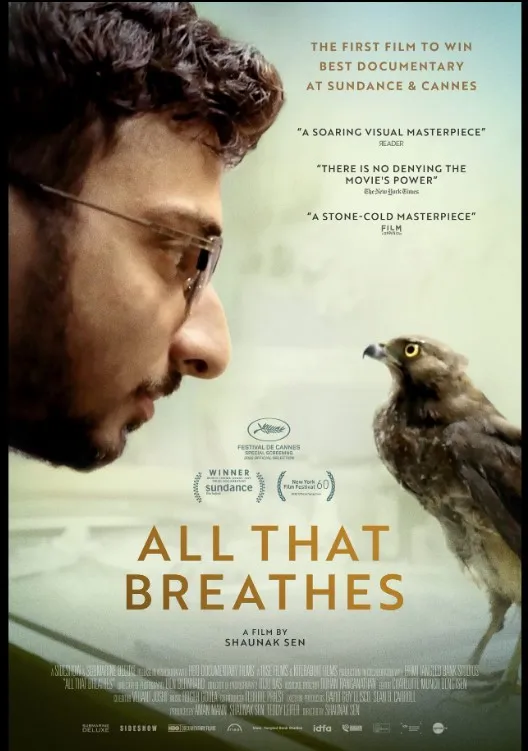All That Breathes review: The Oscar-nominated documentary makes a compelling case for nature in urban chaos
Through the selfless dedication of two brothers, All That Breathes is an introspective exploration of the fragile balance of nature and a period of unpredictable socio-political change in India.
Starring: Nadeem Shehzad, Mohammad Saud, and Salik Rehman
In a dark, dank alleyway somewhere in the vast expanse of Delhi, a camera crawls slowly on the ground to focus on the animals of the night, scurrying around a garbage heap. Rats chitter as they feed on leftovers of food and increase in numbers.
In the background, vehicles honk and drive through, unbothered and unaware of this feeding frenzy as the shot gets overwhelmed by bright white light from a passing truck.
Keeping it real, exposed, and thought-provoking, Shaunak Sen’s All That Breathes sets the tone for a poignant documentary with striking nature photography, capturing life blooming in urban chaos.
Sen’s documentary is a human take on the fragility of the balance of nature, focusing on two brothers, Nadeem Shehzad and Mohammad Saud. Taught by their mother through tales of jinns and fairies about the value of breathing and living life, the brothers run a clinic in their home for black kites—the scavenger birds facing extinction in India’s capital city.
The bird of prey glides through achingly beautiful shots of smog-choked skies and polluting industrial chimneys. Meanwhile, the brothers care for their dwindling population in Wazirabad, Delhi, a village near Civil Lines in North Delhi.
Both struggle through a shortage of funds and an insensitive environment for their mission, as increasingly complex strife of class, religion, and identity clamour in the background.

Without using statistics or subject experts, All That Breathes weaves in a selfless and difficult effort by Shehzad and Saud to save the bird of prey even as conflicts beyond their control escalate within their city and country.
As anti-CAA protests build, the brothers continue surgically treating injured kites. Diving into a cold river, Saud and Salik Rehman, a dedicated volunteer, swim to the other bank to rescue a single kite. When they finally treat injured birds, the camera closes up on them to reflect gentle and vulnerable living beings who need care.
As politics and identity clash, their effort to get foreign funding to save their hospital is rejected by the FCRA. A New York Times article brings them sufficient attention to get appropriate funding, and ‘Animal Rescue’, their hospital, now has space and a signboard.
As pollution eats into every aspect of human life in Delhi, everyone and everything must adjust. Saud has to monitor his young son’s cough regularly; while animals adapt to a changing environment, evolving to fit in.
Shots linger from a human settlement to the backwaters of black drains pouring downwards. At spots like these, pigs cross a cleaner water source even as horses graze in the background. Nature and humans coexist seamlessly in a polluted Delhi as plastic waste and a mountain of garbage continue growing.
All That Breathes is not a direct and clear statement on environmental damage or the volatile undercurrent of communal politics coursing through India today. Rather, it is an introspective narrative showcased through the experiences of individuals living through an unpredictable period of change.
If Saud and Shehzad were to fall or suffer like their beloved black kites, they do not have a safety net. Their dedication, unsung for the most part, emerged from a deep quasi-religious belief. All That Breathes has life and must be treated with respect.
As children, they would lie flat on their backs and spot birds while growing up in a lower-middle-class neighbourhood. Through patches of tarpaulin, black kites seem to glide in the sky like they owned this space.
Building upon a faith-based belief that serving kites means they eat away at one’s bad luck or unhappiness, both set out to save these birds on an impulse. Now, they find reason in living for themselves. “Humans tend to forget that they are also meat,” says Shehzad at one point.
All That Breathes advocates for empathy for life and nature around us without so much as stating this and letting the camera do all the talking.
The documentary has won a cluster of top awards, including Sundance and Cannes. It got an Oscar nomination for Best Documentary. Beyond its golden run, this documentary is an absolute must-watch for the young—for students and anyone who believes in the magic of the movie camera.
Cinematography by Ben Bernhard, Riju Das, and Saumyananda Sahi is worthy of applause. Shaunak Sen’s low-volume but high-impact intensity and courage as a filmmaker is compelling.
All That Breathes is a lesson in empathy and the traditional value of beauty.
Rating: 4.5/5
Edited by Suman Singh







